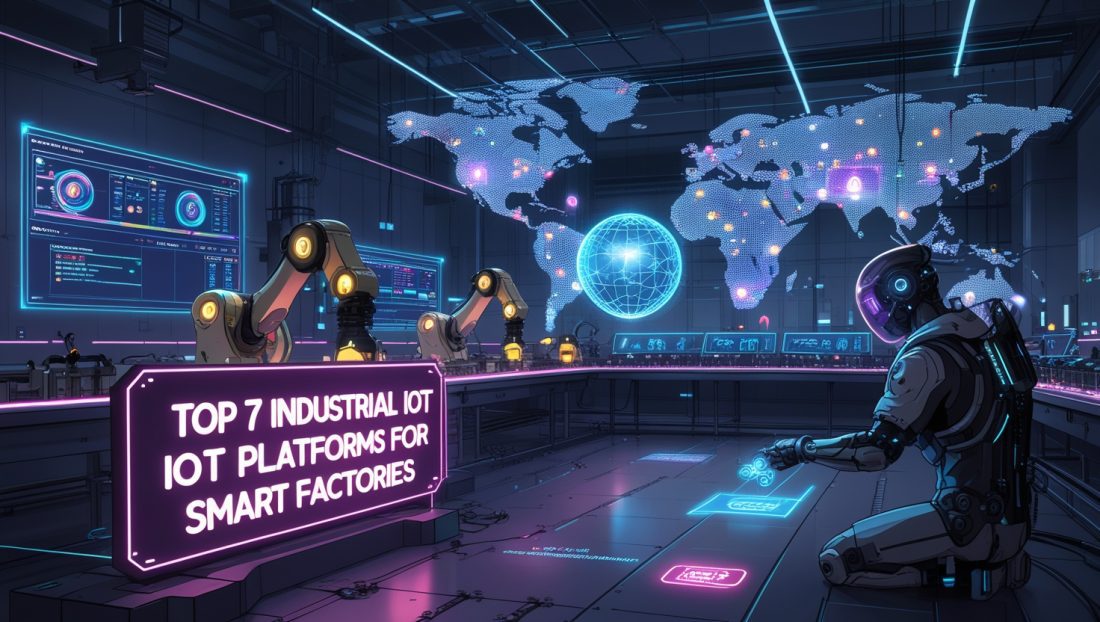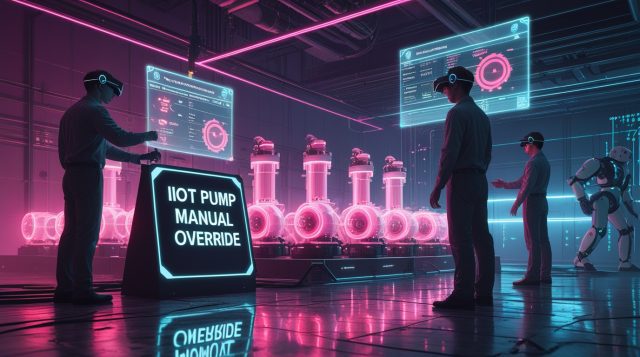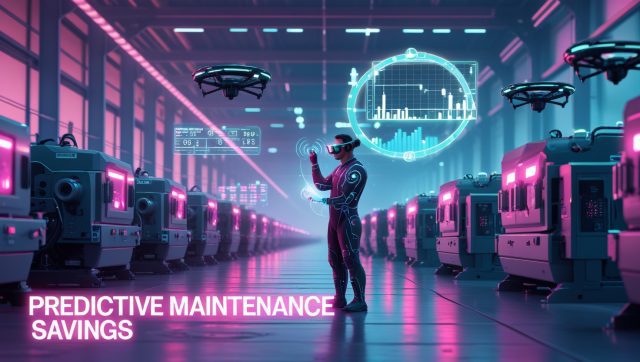Why Connectivity Is the Lifeline of Modern Manufacturing
During a 2024 facility tour at a German automotive supplier, a maintenance alert flashed on a supervisor’s dashboard. An AI model had detected anomalous vibration patterns in a robotic welder—48 hours before potential failure. Technicians replaced a worn gearbox during scheduled downtime, avoiding a $220,000 production halt. This exemplifies industrial IoT platforms transitioning from experimental tools to operational necessities. As factories evolve into cognitive ecosystems, these platforms now determine competitive survival.
Gartner confirms this shift, projecting that 70% of manufacturers will depend on IIoT platforms for core operational decisions by 2026. Yet with 140+ contenders saturating the market, selecting the right solution resembles navigating a maze blindfolded. Let’s demystify the landscape.
To understand how AI-driven predictive maintenance amplifies these platforms’ impact, explore how AI boosts predictive maintenance ROI in 2025.
Evaluation Framework: How We Assessed the Top Contenders
Platforms were scored against five critical benchmarks:
- AI Integration Depth: Machine learning capabilities transforming raw data into predictive insights
- Edge-to-Cloud Architecture: Latency under 10ms for mission-critical operations
- OT/IT Fusion: Native compatibility with legacy SCADA/MES systems
- Cybersecurity Posture: IEC 62443 compliance and zero-trust implementation
- Proven ROI: Documented efficiency gains exceeding 20% in production environments
The Top 7 Industrial IoT Platforms for 2025
1. Siemens MindSphere
Core differentiation: Functions as a plant’s central nervous system. Its physics-based digital twins predict failures with 92% accuracy, slashing unplanned downtime by 40%.
Key capabilities:
- Real-time quality deviation detection using spectral analysis
- Energy optimization algorithms reducing consumption by 18%
- Seamless integration with Siemens PLC ecosystems
Real-world impact: Bosch cut welding defects by 29% through MindSphere’s live parameter adjustments during production runs.
Why MindSphere Excels in Smart Factory Automation
MindSphere’s digital twin technology leverages real-time sensor data to simulate equipment behavior, enabling proactive maintenance. Its ability to integrate with Siemens’ extensive hardware ecosystem ensures compatibility across diverse production lines. For factories aiming to optimize energy usage, MindSphere’s algorithms analyze consumption patterns, offering actionable insights to reduce costs.
This aligns with the growing demand for smart factory automation solutions, a high-intent keyword searched globally. By pairing with industrial AI and digital twins, MindSphere enhances scalability. Learn more about digital twin standards from Siemens’ official insights.
2. PTC ThingWorx
Core differentiation: Merges augmented reality with operational data overlays. Technicians using AR-guided repairs resolve issues 50% faster.
Critical tools:
- Vuforia AR for interactive equipment schematics
- Digital thread tracing components from warehouse to customer
- Closed-loop quality control triggering automatic adjustments
Plant manager testimony: “Our team fixed a CNC calibration error in 23 minutes—a task previously taking two hours—using torque specs overlaid via ThingWorx.”
Why ThingWorx Leads in AR-Driven Manufacturing
ThingWorx’s Vuforia AR overlays real-time data onto physical equipment, streamlining complex repairs. This is critical for AR in industrial maintenance, a trending search term with global appeal. Its digital thread ensures traceability, vital for compliance in regulated industries like aerospace. For manufacturers exploring computer vision in robotics, ThingWorx offers a robust foundation. PTC’s case studies on PTC’s ThingWorx platform highlight its role in reducing repair times.
3. AWS IoT SiteWise
Core differentiation: Processes over 1 million data points per second per production line. Its machine learning services predict failures 72 hours ahead with 95% accuracy.
Technical advantages:
- Monitron wireless vibration sensing for rotating equipment
- Lambda functions enabling custom anomaly detection logic
- Sustainability tracking aligned with ISO 50001 standards
Documented outcome: Armal reduced energy costs by 40% using real-time load balancing across compressors.
Why AWS IoT SiteWise Powers Predictive Analytics
SiteWise’s Monitron sensors deliver granular vibration data, enabling precise failure predictions for predictive analytics in manufacturing. Its Lambda functions allow custom algorithms, giving factories flexibility to tailor solutions. This scalability suits edge AI vs. cloud AI strategies. AWS’s documentation on IoT SiteWise details its energy optimization capabilities, which are critical for achieving sustainability goals.
4. Microsoft Azure IoT
Core differentiation: Hybrid architecture bridging legacy equipment with cloud AI. Azure Percept edge hardware accelerates computer vision deployment by 60%.
Strategic benefits:
- Azure Digital Twins simulating factory-wide material flow
- Synapse Analytics correlating OT/IT data streams
- Defender for IoT detecting threats in under 200ms
Expert analysis: “Manufacturers with mixed-vintage equipment benefit from Azure’s ‘brownfield agility’” – IoT World Today.
Why Azure IoT Excels in Legacy Integration
Azure’s protocol translators ensure seamless integration with older SCADA systems, addressing legacy system integration in smart factories. Its Defender for IoT provides robust cybersecurity, critical for protecting connected devices. For manufacturers adopting AI-driven cybersecurity, Azure offers a strong framework. Microsoft’s Azure IoT overview showcases its hybrid cloud capabilities.
5. Software AG Cumulocity IoT
Core differentiation: Low-code application builder enabling custom tool deployment in days versus months. Pre-built industry templates cut integration costs by 60%.
Standout features:
- Drag-and-drop workflow designer requiring minimal coding
- Edge-to-cloud data orchestration with MQTT support
- Asset-as-a-Service (AaaS) monetization models
Implementation case: A European pharmaceutical company built a GDPR-compliant tracking system in 11 days.
Why Cumulocity Simplifies IoT Customization
Cumulocity’s low-code platform empowers non-technical teams to build custom IoT applications, ideal for low-code IoT development. Its MQTT support ensures efficient data transfer, enhancing real-time decision-making. For factories exploring AI in supply chain management, Cumulocity’s flexibility is a game-changer. Software AG’s Cumulocity IoT guide highlights its rapid deployment benefits.
6. IBM Maximo
Core differentiation: Leverages 30+ years of reliability data for failure chain prediction. Its AI-powered graphs identify secondary failure risks most platforms miss.
Operational strengths:
- PMQ Optimizer dynamically reschedules maintenance
- TRIRIGA integration for emissions compliance tracking
- Watson NLP automating technician work orders
Performance data: Users report 25% lower spare parts inventory through precision forecasting.
Why Maximo Dominates Asset Management
Maximo’s Watson NLP automates work orders, reducing manual errors in asset management automation. Its failure chain prediction minimizes cascading issues, a key advantage for complex plants. For insights on industrial AI agents, Maximo’s AI capabilities align perfectly. IBM’s Maximo overview details its predictive maintenance strengths.
7. Rejig Digital Arete
Core differentiation: Specializes in multi-site anomaly correlation. Its distributed AI identifies bottlenecks across global factories through cross-fleet learning.
Innovative advantages:
- Energy fingerprinting for Scope 3 carbon accounting
- Federated learning preserving local data privacy
- No-code dashboard builder for operational teams
Efficiency gain: Clients achieve 18% OEE improvements via synchronized production tuning.
Why Arete Excels in Multi-Site Optimization
Arete’s federated learning ensures data privacy while optimizing multi-site manufacturing efficiency. Its no-code dashboards empower teams to monitor KPIs in real time. For manufacturers adopting blockchain-verified processes, Arete’s secure data sharing is a strong fit. Rejig’s Arete platform page outlines its cross-site analytics capabilities.
Implementation Blueprint: Avoiding Costly Missteps
Deploying IIoT platforms requires methodical execution. Follow this field-validated sequence:
- Edge-first instrumentation: Install vibration/temperature sensors on 3 mission-critical assets
- Data pipeline construction: Implement MQTT or OPC UA for secure, lossless ingestion
- Edge preprocessing: Filter 80% of noise data locally before cloud transmission
- Digital shadow creation: Build non-real-time replicas for initial analytics
- Closed-loop activation: Automate one process (e.g., thermal adjustment)
- Horizontal scaling: Add two production lines monthly after stability confirmation
Critical insight: Cisco’s 2025 analysis found 73% of failed deployments neglected organizational change management. Train teams before they go live. For deeper insights, check why robotics in 3D printing unlocks potential.
Emerging Trends Reshaping 2025-2027
- Generative AI Integration: Siemens’ Industrial Copilot creates maintenance scripts from voice notes, cutting documentation time by 70%. Learn more about AI audio search transforming decisions.
- 5G URLLC Networks: Sub-1ms latency enabling wireless robotic control in BMW’s Spartanburg plant.
- Carbon-Intelligent Operations: Platforms auto-optimize for Scope 3 emissions using real-time energy data. See how AI slashes energy costs in manufacturing.
- Blockchain Verification: Secure quality data sharing across supply chains at Renault.
The Strategic Imperative
Selecting an industrial IoT platform transcends technology procurement—it determines factory viability. As FourJaw’s CEO notes: “By 2027, unconnected factories will face 30% cost disadvantages.”
The leaders profiled deliver measurable transformation: less downtime, sustainable operations, and workers augmented by intelligence—not replaced. Begin by piloting one high-impact use case. That German supplier? It now operates at 96% OEE. Your move.
FAQ: Critical Questions Answered
What ROI timeframe should manufacturers expect?
Most platforms deliver payback in 8-14 months. PTC ThingWorx users report 23% lower maintenance costs within six months.
How do platforms handle legacy equipment integration?
Solutions like Azure IoT and Software AG use protocol translators (Modbus to MQTT) and edge gateways, avoiding rip-and-replace scenarios.
What cybersecurity standards apply?
Prioritize IEC 62443 compliance, TLS 1.3 encryption, and zero-trust frameworks like those in IBM Maximo.
Can SMEs afford industrial IoT platforms?
Cloud-based options like AWS IoT offer usage-based pricing, with entry points below $0.50 per device monthly.
How does 5G enhance IIoT deployments?
Ultra-reliable low-latency communication (URLLC) enables wireless machine vision and closed-loop control previously requiring wired connections.



